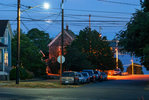Streetlights in Port Townsend are to become more efficient, less expensive to maintain, and retain a warm, orangish color temperature as high-pressure sodium vapor bulbs in the city are slowly …
This item is available in full to subscribers.
We have recently launched a new and improved website. To continue reading, you will need to either log into your subscriber account, or purchase a new subscription.
If you had an active account on our previous website, then you have an account here. Simply reset your password to regain access to your account.
If you did not have an account on our previous website, but are a current print subscriber, click here to set up your website account.
Otherwise, click here to view your options for subscribing.
* Having trouble? Call our circulation department at 360-385-2900, or email our support.
Please log in to continue |
|


Streetlights in Port Townsend are to become more efficient, less expensive to maintain, and retain a warm, orangish color temperature as high-pressure sodium vapor bulbs in the city are slowly switched to light-emitting diode (LED) bulbs.
The City Council on Aug. 21 voted unanimously to approve a new interim lighting standard for city streetlamps that favors LEDs.
Almost all city streetlights are currently high-pressure sodium vapor lights, said Ken Clow, public works director for the city.
“We’ve had that standard for probably 20 years. But the technology is finally changing,” he said of changing to LEDs.
Clow said city staff has been evaluating options for street lighting and for replacement of existing lights for the past year.
The Jefferson County Public Utility District (PUD) owns and maintains all but nine of the 548 streetlights in Port Townsend, he said. The bulbs would be switched over as the sodium vapor ones burn out.
“The primary benefits [of LEDs] are much-reduced energy consumption for the same amount of … light,” he said. The LEDs also last longer – about 10 years – compared to the five years that high-pressure sodium vapor bulbs tend to last.
The longer duration also reduces costs, because the LEDs don’t require as much maintenance.
Clow said the city spends about $103,000 per year for the city’s 548 PUD-owned streetlights, most of which are 100 watts. Some are 150 watts, and one is 250 watts.
COST REDUCTION
“By going to LEDs we would reduce the cost per light by $2.25 per month. If we convert all of those lights that we have right now to LEDs, that’s $15,000 per year that we save,” he said.
Over time, the PUD would adjust the rates for the lights if it finds maintenance costs are reduced. Clow said the lower maintenance costs would save the city more money than would be saved from the increased energy efficiency.
Clow said the PUD policy now makes LEDs the standard and that the PUD would prefer to install LEDs throughout the city. He added that the PUD would continue to use sodium vapor lights if the city prefers them.
Clow said the LED lamps can be dimmed, while sodium vapor lamps cannot.
The LEDs can also be programmed to dim at different times to reduce energy use and also to reduce impacts on neighborhoods.
Clow added that the PUD would like to turn over possession of the lights to the city and only charge the city for the electricity that is used, but he said that isn’t a good deal for the city.
LED lighting was also endorsed by the city’s climate action committee because of the lower carbon emissions associated with more energy-efficient bulbs.
COLOR TEMPERATURE
The color of light coming from a bulb varies and is measured using the Kelvin scale (with units called kelvins, or “K”), a temperature scale used for, among other things, indicating the color of light. Lower numbers, such as 2,000-3,000K, are oranger, and larger numbers, such as 4,000K and higher, are bluer.
Clow said older models of the LED lights were 5,000K.
“That was a very blue, white light, very bright,” he said.
“Our lights, the sodium vapors, are 2,700K – very orange-looking light. Until recently, LEDs couldn’t match that color. They’ve come closer. And more recently, they’ve come out with a 3,000-kelvin bulb,” Clow said.
“We have those up on Lawrence Street,” he said, along with examples of 3,000K and 4,000K lights. There are 10 sample lights on Lawrence Street between Pierce and Taylor streets, giving members of the public the opportunity to look at the lights, see the differences and then voice their opinions as the city finalizes its policy on the streetlights.
“Most people favor the 3,000-kelvin over the cooler, bluer 4,000 and certainly the 5,000-kelvin lights,” he said.
According to a city document on the LEDs, “There is debate over the health effects of LED lights from the blue color spectrum. The American Medical Association has come out with recommendations on LED streetlight installation, which include the recommendation to use lower temperature lights (3,000K) and to shield them from residences.”
Another issue with the LED lamps is that they have a very bright bulbs, which are glaring if looked at directly, so diffusers may be installed over the bulbs to make the light softer and diffuse.
A permanent lighting policy is to be drafted in a year, he said.